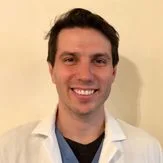Blind Curve
It was early evening. My wife and I were walking our dog in front of our apartment. I heard screeching brakes followed by screams. I had heard the brakes before, but the screams were new. We live down the street from a sharp turn where the speed limit rapidly drops without much warning. A children's playgroup meets just East of the turn. When I jumped the fence my worst fears of multiple bystander injuries were relieved, but the scene confirmed a high speed front-end collision into a tree. Two bodies were lifeless in the car. One woman was kneeling and screaming with obvious head trauma. She was essentially "scalped". Her scalp had been completely avulsed and was peeled over her face exposing her galea and frontalis muscle. A fourth man had been thrown from the car and was unconscious with agonal breathing. I felt a strong pulse on him and serendipitously a caretaker from the children's group handed me a pocket rescue breathing mask.
Suddenly my wife was at my side and began holding C-spine for the "scalped" woman. A nurse that happened to be nearby came to assist as well. When we lost pulses on the agonal breather the nurse and I began CPR. I felt windshield glass cut my palms when performing chest compressions. Quickly a bystander volunteered their jacket as a barrier.
After paramedics arrived five minutes of closed chest compressions and a thready pulse were (reasonably) not enough for them to intubate. After all, a thoracotomy was the only hail Mary that could have saved this resuscitation. In the end, two men were dead on impact, a man with a pulse died in the field. And a woman with a degloving facial injury was taken to a level one trauma center and survived. I can not reasonably say that my efforts as an emergency medicine physician had any impact on these outcomes.
Despite the many traumatic deaths I have dealt with in the Emergency Room this one will never leave my memory. The traumas I deal with in the ER have already been recovered from dire situations, transported by EMTs, and arrived in a recognizable trauma package. I had never accounted for the screams and terror of bystanders and the unpackaged gore that happens in the moment. There is no accounting for the humility that comes with a life that is lost moments after impact.
When I am feeling particularly optimistic I do relish that even in unfamiliar terrain I was able to be a resuscitation leader. I am also heartened how eagerly amateur bystanders were willing to provide assistance. I am happy that we were able to take a moment of chaos and provide a modicum of control. Still, it is hard to escape the feeling of futility and loss that now haunts this street whenever I walk by. Though thankfully now protective barriers and cautionary signs protect future pedestrians as well as the tree that now acts as a makeshift memorial.
This is news coverage from the accident:
Share your blind turn story in the comment story.
Subscribe to the blog by entering your email in the subscription box below. Don't rely on Facebook to get notifications for new posts. We only email when a new post is published. No spam. If you are reading this on your phone, just keep scrolling down to get to the Subscribe box.
Give us some love by sharing the blog. Forward the blog to people you think would like it. Post the blog on social media. Like and Follow our Facebook Page. Follow us on Twitter. Follow us on Instagram
Dr. Blair’s Bio is Below Keep Scrolling Down
Dr. Thomas Blair
Emergency Medicine Physician. County Trained.
Health Sciences Assistant Clinical Professor of Emergency Medicine, David Geffen School of Medicine at UCLA.



